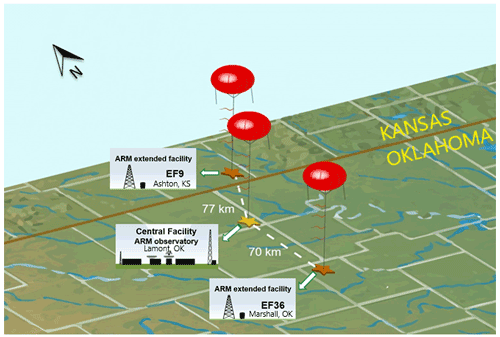2024-04-15 パシフィック・ノースウェスト国立研究所(PNNL)
<関連情報>
- https://www.pnnl.gov/publications/scratching-surface-aerosols-uncrewed-aerial-systems
- https://journals.ametsoc.org/view/journals/bams/105/3/BAMS-D-23-0110.1.xml
- https://essd.copernicus.org/articles/14/3423/2022/
新しい観測能力とプロセスレベルのシミュレーションの橋渡し: 地球システムにおけるエアロゾルの役割に関する洞察 Bridging New Observational Capabilities and Process-Level Simulation: Insights into Aerosol Roles in the Earth System
Fan Mei,Hailong Wang,Zihua Zhu,Damao Zhang,Qi Zhang,Jerome D. Fast,William I. Gustafson Jr.,Xiang-Yu Li,Beat Schmid,Christopher Niedek,Jason Tomlinson, and Connor Flynn
Bulletin of the American Meteorological Society Published:02 Apr 2024
DOI:https://doi.org/10.1175/BAMS-D-23-0110.1

Abstract
The spatial distribution of ambient aerosol particles significantly impacts aerosol–radiation–cloud interactions, which contribute to the largest uncertainty in global anthropogenic radiative forcing estimations. However, the atmospheric boundary layer and lower free troposphere have not been adequately sampled in terms of spatiotemporal resolution, hindering a comprehensive characterization of various atmospheric processes and impeding our understanding of the Earth system. To address this research data gap, we have leveraged the development of uncrewed aerial systems (UAS) and advanced measurement techniques to obtain mesoscale spatial data on aerosol microphysical and optical properties around the U.S. Southern Great Plains (SGP) atmospheric observatory. Our study also benefits from state-of-the-art laboratory facilities that include three-dimensional molecular imaging techniques enabled by secondary ion mass spectrometry and nanogram-level chemical composition analysis via micronebulization aerosol mass spectrometry. Through our study, we have developed a framework for observation–modeling integration, enabling an examination of how various assumptions about the organic–inorganic components mixing state, inferred from chemical analysis, affect clouds and radiation in observation-constrained model simulations. By integrating observational constraints (derived from offline chemical analysis of the aerosol surface using collected samples) with in situ UAS observations, we have identified a prominent role of organic-enriched nanometer layers located at the surface of aerosol particles in determining profiles of aerosol optical and hygroscopic properties over the SGP observatory. Furthermore, we have improved the agreement between predicted clouds and ground-based cloud lidar measurements. This UAS–model–laboratory integration exemplifies how these new advanced capabilities can significantly enhance our understanding of aerosol–radiation–cloud interactions.
グレートプレーンズ南部の無人システムの観測データ Observational data from uncrewed systems over Southern Great Plains
Fan Mei, Mikhail S. Pekour, Darielle Dexheimer, Gijs de Boer, RaeAnn Cook, Jason Tomlinson, Beat Schmid, Lexie A. Goldberger, Rob Newsom, and Jerome D. Fast
Earth System Science Data Published:28 Jul 2022
DOI:https://doi.org/10.5194/essd-14-3423-2022

Abstract
Uncrewed Systems (UxS), including uncrewed aerial systems (UAS) and tethered balloon/kite systems (TBS), are significantly expanding observational capabilities in atmospheric science. Rapid adaptation of these platforms and the advancement of miniaturized instruments have resulted in an expanding number of datasets captured under various environmental conditions by the Department of Energy (DOE) Atmospheric Radiation Measurement (ARM) user facility. In 2021, observational data collected using ARM UxS platforms, including seven TigerShark UAS flights and 133 tethered balloon system (TBS) flights, were archived by the ARM Data Center (https://adc.arm.gov/discovery/#/, last access: 11 February 2022) and made publicly available at no cost for all registered users (https://doi.org/10.5439/1846798) (Mei and Dexheimer, 2022). These data streams provide new perspectives on spatial variability of atmospheric and surface parameters, helping to address critical science questions in Earth system science research. This paper describes the DOE UAS/TBS datasets, including information on the acquisition, collection, and quality control processes, and highlights the potential scientific contributions using UAS and TBS platforms.


